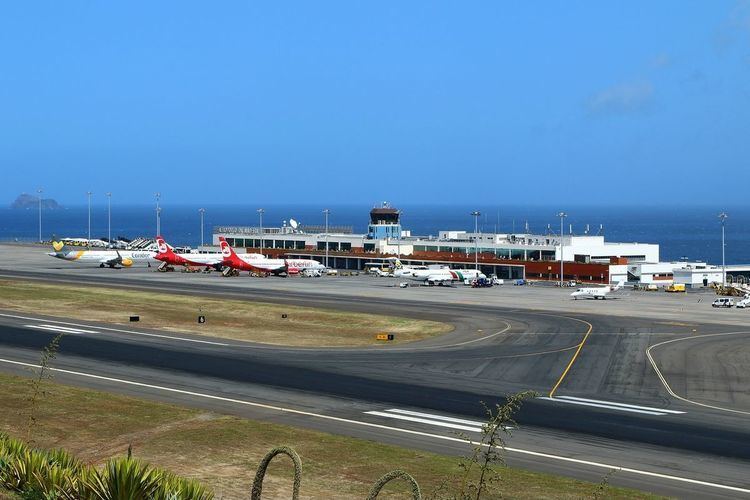Airport type Public Elevation AMSL 58 m / 190 ft Code FNC Number of runways 2 | Operator ANA Website ana.pt Elevation 59 m Phone +351 291 520 700 | |
 | ||
Address 9100-105 Santa Cruz, Madeira, Portugal | ||
Plane attempts to land at madeira airport in strong winds
Madeira Airport (Portuguese: Aeroporto da Madeira ), informally also known as Funchal Airport (Aeroporto do Funchal) (IATA: FNC, ICAO: LPMA), is an international airport in the civil parish of Santa Cruz, in the Portuguese archipelago of Madeira. The airport is located 13.2 km (8.2 mi) east-northeast of the regional capital Funchal after which it is sometimes informally named. It mostly hosts flights to European metropolitan destinations due to the importance of Madeira as a leisure destination. It is the fourth busiest airport in Portugal.
Contents
- Plane attempts to land at madeira airport in strong winds
- Funchal madeira airport spotting spectacular landings departures
- History
- Runway
- Terminal
- Modernisation
- Accidents and incidents
- References
The airport is considered one of the most peculiarly perilous airports in the world due to its location and its spectacular runway construction. The History Channel program Most Extreme Airports ranked it as the ninth most dangerous airport in the world, and the third most dangerous in Europe after Gibraltar International Airport and Courchevel Altiport.
The airport is set to be renamed Madeira Airport – Cristiano Ronaldo in honour of Portuguese footballer Cristiano Ronaldo. The unveiling of the rebranded terminal will take place on 29 March 2017.
Funchal madeira airport spotting spectacular landings departures
History
Madeira Airport was officially opened on 18 July 1964, with two 1,600 m (5,249 ft) runways. The first flight ever to land was a TAP Air Portugal Lockheed Constellation with 80 passengers on board.
In 1972, the popularity of visiting the island of Madeira increased, so the runway had to be extended to allow modern and larger aircraft to land. Considered the Kai Tak of Europe because of its singular approach to runway 05, the decision was made to extend the existing runway, instead of building a new one. In the meantime, a brand new terminal was built at the airport in 1973, handling 500,000 passengers.
The new runway and terminal were inaugurated on 6 October 2002, and to mark the occasion, an Air Atlanta Icelandic Boeing 747-200, registration TF-ABA, landed at the airport. Although this was a rare event, some TAP Portugal flights currently make scheduled stops at Madeira with Airbus A330-200 widebody aircraft on the Lisbon-Caracas-Lisbon route.
In 2016, it was announced that the airport will be named as Madeira Airport – Cristiano Ronaldo (Aeroporto da Madeira – Cristiano Ronaldo) in honour of Madeira native football player Cristiano Ronaldo.
Runway
The airport was once infamous for its short runway which, surrounded by high mountains and the ocean, made it a tricky landing for even the most experienced of pilots. Between 1982 and 1986, Madeira's runway was successfully extended by 200 m (656 ft) to a total of 1,800 m (5,906 ft), and also four gates were opened. The original runway was only 1,600 m (5,249 ft) long, but was extended by 200 m (656 ft) 8 years after the TAP Portugal Flight 425 crash of 1977.
In 2000, the runway was again extended this time to 2,781 m (9,124 ft) almost doubling the size of the original runway. As landfill was not a realistic option, the extension was built on a platform, partly over the ocean, supported by 180 columns, each about 70 m (230 ft) tall. The extension of Madeira Airport was conducted by the Brazilian construction company Andrade Gutierrez, and is recognized worldwide as one of the most difficult to achieve due to the type of terrain and orography.
Its innovative solution allowed Funchal to receive the Outstanding Structure Award in 2004 by the International Association for Bridge and Structural Engineering, which aims at recognizing the most remarkable, innovative, creative or otherwise stimulating structure completed within the last few years.
Terminal
The airport has a single terminal which opened in 1973. The terminal has 40 check-in desks, 16 boarding gates and 7 baggage belts. There are no air-bridges so passengers either walk the short distance to the terminal or are taken by shuttle bus. The terminal itself is mostly underground.
Modernisation
In 2016, Madeira Airport was modernised and renovated by its operator, ANA Aeroportos de Portugal, as part of an €11 million investment. The renovated terminal area, which was opened in June 2016, by the President of the Autonomous Regional Government of Madeira, Miguel Albuquerque, ameliorated the existing 'operational facilities' and facilitated the creation of a brand new shopping area - all in all, doubling the capacity of the airport as a single entity.
According to VINCI Airports, the airport will now "have the capacity to deal with up to 1,400 passengers per hour", and the airport's overall new layout has been designed to enable to accommodation of new stores for national and international brands alike.
The passenger screening area, under the command of Serviço de Estrangeiros e Fronteiras, increased from 650m² to 1,500m² accommodating an increase of the number of security screening lines, while the passenger holding and verification area also increased from 300m^2 to 650m^2. The new adopted layout has overall simplified passenger experience, creating defined areas for Schengen - which the Autonomous Region of Madeira is part of - and non-Schengen and given ANA Aeroportos de Portugal, the operator, the inherent faculty to alternate the terminal based on scheduling. A brand new transfer hall, and 3 new departure gates were also created as part of the project.
Furthermore, the renovation and investment project also accommodated the strengthening and re-profiling of the runway and taxiways, increasing the area usable by in excess of 1,500 m².
